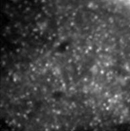A breakthrough discovery that has shown how plants may defend themselves in the face of pathogen attacks could hold the key to making crops more disease-resistant and to boosting food production to help global food security.
As part of a
BBSRC (link opens in a new window)-funded project led by Oxford Brookes University, STFC’s Central Laser Facility has developed a unique technique that has answered a question which has puzzled scientists for many years – why certain proteins in plant cells don’t move around as much as their counterparts in animal cells.
By enabling the movement of individual molecules in living plant cells to be observed in real time for the first time, the new technique has revealed that the cell wall plays a crucial role in limiting the mobility of proteins produced when a plant comes under attack. Specifically, it has shown that the cell wall allows these proteins to stabilise in the plasma membrane (a ‘skin’ covering the inside of the cell wall). This restricts their ability to move around and fight invading pathogens and so increases the plant’s vulnerability.
Dr Stan Botchway from the Lasers for Science division within the Central Laser Facility says: “The technique we’ve developed and deployed to solve this mystery has helped provide unprecedented insights into plants’ defence mechanisms. As a result, we’ve plugged a major gap in scientists’ understanding of how plants function at a microscopic level.”
Dr John Runions of Oxford Brookes University, who has led the project, says: “This vital advance in our knowledge of the fundamental biological processes that take place in living plant cells will help us to improve crops’ resilience and their ability to meet the challenges posed not just by diseases and pests but also by drought and a warming climate.”

OCTOPUS reveal discrete single molecules in plant. Small particles are observed with a total internal reflection fluorescence microscope (TIRFM) - invisible with standard confocal microscopy.
(Credit: Dr John Runions, Oxford Brookes University)The breakthrough has been achieved using a single-molecule tracking technique specially developed at the OCTOPUS (Optics Clustered to OutPut Unique Solutions) imaging facilities, which form part of the world-leading Central Laser Facility’s Lasers for Science division, located in the Research Complex at Harwell. This was complemented by the use of total internal reflection fluorescence (TIRF) microscopy – an established technique which, by eliminating background fluorescence, delivers extremely high-resolution images of samples under investigation.
The result was a clear demonstration that a plant’s cell wall interacts with proteins produced in cell membranes and restricts their diffusion, possibly reducing their ability to ward off diseases.
As the world’s population continues to grow, there is an urgent need to improve crop yields by enhancing the resilience of a range of crops to disease. This research project therefore represents a crucial stepping stone in bringing the sustainability of future food supplies within closer reach.
The research paper outlining this major discovery in plant biology has just been published in the
Proceedings of the National Academy of Sciences (link opens in a new window).
